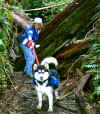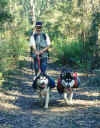|
 Backpacking
with your Malamute Backpacking
with your Malamute
Backpacking
is an enjoyable activity for
you and your Malamute. Anyone can have a go at hiking with their dog as long as
the dog is in good health, is reasonably fit and you have the right equipment.
The
only specialised equipment you'll need is a canine backpack for your dog. You'll
also require a sturdy lead (6 - 8 feet long is ideal) & comfortable collar,
dog-towel (if conditions are wet), food, water & water bowl for your dog,
and a basic first aid kit as well as your own requirements. Be
aware that Malamutes are a breed that must be walked on lead at all times -
wildlife will almost certainly be encountered on your hike and will often pose
an irresistible temptation to even the most obedient of Malamutes!
If
you are just interested in hiking with your dog for fun, you can put items such
as food, drink and clothing in his pack - as much or as little as you like,
keeping in mind that the dog should not carry more than 30% of his body weight.
And those backpacks can also be put to good use when you and your Mal go to the
shops - any self-respecting Malamute will be more than happy to carry home his
dinner!
Training
Training
should begin with walking you dog with an empty or lightly loaded pack to get
him or her used to the feel of it, and to ensure that the pack is fitted
correctly and is comfortable for the dog. Once the dog is used to wearing the
pack, gradually increase the weight and the distance of your walks. By building
up the weight in this way, any problems with your dog or the backpack should
become apparent before you find yourself miles from anywhere participating in a
long distance hike.
 Any
reasonably fit, healthy, sound and mature Malamute should be able to carry a
loaded backpack on a hike. Having said that, it is always advisable to
take your dog to a vet and/or veterinary chiropractor before you embark on any
strenuous event to ensure that your dog is in peak condition and doesn’t have
any underlying health or structural problems. Having your Malamute's hips
x-rayed and assessed for hip dysplasia is also advisable. Undetected health
problems may be exacerbated by working activities such as weight-pulling, racing
and backpacking, and you and your dog certainly don't want any unpleasant
surprises when you're miles from nowhere on a long distance hike. If your
dog does develop a serious problem it could be several hours before you can get
veterinary attention. For this reason, and for your own safety, it is always
best if you hike with someone else. Any
reasonably fit, healthy, sound and mature Malamute should be able to carry a
loaded backpack on a hike. Having said that, it is always advisable to
take your dog to a vet and/or veterinary chiropractor before you embark on any
strenuous event to ensure that your dog is in peak condition and doesn’t have
any underlying health or structural problems. Having your Malamute's hips
x-rayed and assessed for hip dysplasia is also advisable. Undetected health
problems may be exacerbated by working activities such as weight-pulling, racing
and backpacking, and you and your dog certainly don't want any unpleasant
surprises when you're miles from nowhere on a long distance hike. If your
dog does develop a serious problem it could be several hours before you can get
veterinary attention. For this reason, and for your own safety, it is always
best if you hike with someone else.
As
Malamutes can be slow to physically mature, we do not backpack our dogs with
loaded packs until they are at least 18 months of age. Most fit, healthy
puppies however should be able to complete a long hike with a very lightly
loaded pack at the age of 12 months. In all cases, we watch our dogs very
carefully throughout the hike for signs of discomfort. Some indications
that a dog is not coping well are:
- dog lagging behind
- dog dragging his feet
- dog walking with tail down
- dog not keen to get going again after a rest stop.
Assess
your dog and be objective, if he is not appearing to enjoy the hike then relieve
him of his load. Let's face it, I'm sure the dog would enjoy the hike just
as much, or even more, if he didn't have to carry a pack.
Offer
your dog water at frequent intervals and plan plenty of rest stops during longer
hikes. Use your rest stops to relieve your dog of the weight of the pack
and check that the pack is sitting comfortably on the dog and not rubbing. - If
you have a 2-piece pack (separate saddle section and pannier bag section) and
are only stopping for a short time, you have the advantage of being able to
remove the weight of the pannier bags from your dog without having to undo the
straps and remove the whole pack. If the pack or your dog gets wet during
the hike, it is advisable to dry the dog and pack off as much as possible before
recommencing your walk.
If
you are hoping to achieve a backpacking title for your dog please do not put
your dog's welfare at risk - if he's not enjoying it don't force him to keep
walking and carrying weight for the sake of earning a title. The dog
doesn't care if he has a title or not.
 The
Backpack The
Backpack
The
most important piece of equipment for hiking with your dog will be the backpack.
This is not an item that should be scrimped on, if you are intending to do some
long hikes or pursue a title for your dog it's well worth the expense to
get a sturdy, waterproof 2-piece backpack (See Windchill
Dog Gear website).
It
is important that you have a pack of suitable size for your dog and that you
know how to adjust the pack so that it is fitted correctly and is most
comfortable for the dog. The backpack should sit over the withers (shoulders),
so that the weight is transferred down to the ground through the front legs and
feet. The pack should never sit on the dogs lower back. The lower back is
the weakest area of the dog’s spine as there is no support from the rib cage
or pelvis, and this area should never bear any weight. If you are not sure that
your dogs pack is fitted correctly, please check with an experienced backpacker.
A badly fitted pack will be uncomfortable for the dog, may rub and, in the worst
case, cause injury.
 The
pack should also not be too large. The pannier bags should not hang so low that
they hit against the legs of the dog as he walks, and the saddle should not
extend beyond the upper section of the back. The
pack should also not be too large. The pannier bags should not hang so low that
they hit against the legs of the dog as he walks, and the saddle should not
extend beyond the upper section of the back.
The
pack must be loaded and the straps adjusted so that it remains centred along the
topline of the dog and cannot slip from side to side. The weight in each side of
the pack must be equal, so if weight is taken from one side (ie water is
consumed from a drink container in one side of the pack) the weights in the pack
will need to be redistributed.
It
is important that the weight is loaded and distributed in the pack in such a way
that it does not shift while the dog is walking. If the weights can shift in the
pack it will result in redistribution of the weight along the dog's topline
towards the lower back which may lead to injury. It is better to have a
smaller pack that is fully loaded than a larger pack that is half empty - the
former will sit more comfortably on the dog.
If
your dog is negotiating obstacles on a walk, such as climbing over a log, assist
your dog by taking the weight of the pack. In difficult situations it is
advisable to remove the dog’s pack and put it back on after the obstacle has
been safely negotiated to prevent injury to the dog.
Working
Pack Dog Titles
Several
breed clubs now offer a Working Pack Dog title which is available to registered
Alaskan Malamutes who have met the requirements of the working dog program. In
most cases the program requires that your dog will have to carry 30% of its body
weight on four 16 kilometre hikes to qualify for the pack dog title. A dog
weighing 40 kilograms would therefore have to carry 12 kilograms of weight,
which is the equivalent of 12 litres of water. Obviously, it is recommended that
you and your dog don't attempt this unless you are both fit, healthy and have
done some training.
 Obviously
you will require a sturdy backpack which is sufficiently large to hold the
required weights, so it's best to get some advice before going to the expense of
buying a pack. The weight is usually made up of something that is dense yet can
mould to the shape of your dog: bags of rice, bags of damp sand and/or a soft
pack of water (similar to the bladder of a wine cask) are suitable. The
only permissible reduction in pack weight over the duration of the hike is by
consumption of food and water by your dog, so making up some of the weight with
water for your dog is strongly advised. Obviously
you will require a sturdy backpack which is sufficiently large to hold the
required weights, so it's best to get some advice before going to the expense of
buying a pack. The weight is usually made up of something that is dense yet can
mould to the shape of your dog: bags of rice, bags of damp sand and/or a soft
pack of water (similar to the bladder of a wine cask) are suitable. The
only permissible reduction in pack weight over the duration of the hike is by
consumption of food and water by your dog, so making up some of the weight with
water for your dog is strongly advised.
Be
aware that there are many areas in which you are not permitted to have a
dog, including National Parks, so check before your big excursion that you and
your dog won't be breaking any laws just by being there.
Many
breed clubs hold several backpacking events each year and anyone with a healthy
and fairly fit dog can go along. Contact your State's Alaskan Malamute breed
club for further information about backpacking with your dog, backpacking events
and their working dog title program.
If
you are interested in trying your dog out at backpacking visit the Alaskan
Malamute Club, Victoria website at www.users.bigpond.com/amcv/
for more information and details of backpacking events. If you are
interested in purchasing a canine backpack for your dog go to the Windchill Dog
Gear website at www.windchill.com.au.
Happy
Hiking!
|